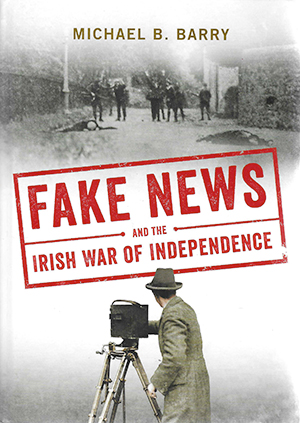FAKE NEWS AND THE IRISH WAR OF INDEPENDENCE
Published in Book Reviews, Book Reviews, Issue 1 (January/February 2022), Reviews, Volume 30 MICHAEL B. BARRY
MICHAEL B. BARRY
Andalus Press
€15.99
ISBN 9780993355486
Reviewed by Maurice Walsh
Maurice Walsh is the author of Bitter freedom: Ireland in a revolutionary world 1918–1923 (Faber & Faber, 2015).
The Irish War of Independence coincided with the birth of the age of propaganda. The American journalist Walter Lippmann—who had done his bit to help President Woodrow Wilson spread his gospel of self-determination—reflected that the success of censorship and propaganda in Britain and the US during the First World War had created a crisis of journalism. ‘If I lie in a lawsuit involving the fate of my neighbour’s cow, I can go to jail,’ Lippmann wrote after the war. ‘But if I lie to a million readers in a matter involving war and peace, I can lie my head off, and, if I choose the right series of lies, be entirely irresponsible.’
Exaggerated stories of German atrocities in Belgium, and euphemistic reports from the Western Front that portrayed carnage such as the Battle of the Somme in sporting metaphors, all succeeded in maintaining morale but left a sour taste. Meeting foreign correspondents in London to press Ireland’s cause, Desmond FitzGerald was impressed by how their experience of the war had made them wary of anything they regarded as propaganda. Critics scorned the press for its docility during the war and its vulnerability to manipulation by powerful interests. H.G. Wells complained of ‘a considerable increase of deliberate lying in the British press since 1914, and a marked loss of journalistic self-respect’.
The war in Ireland provided correspondents for liberal newspapers such as the Manchester Guardian and The Times the opportunity to reclaim their tainted professional esteem by challenging their government’s version of events. Unlike during the First World War, British élite opinion split as the nature of the dirty war in Ireland was slowly unveiled. To many British eyes, reprisals and the indiscipline of the Auxiliaries and the Black and Tans, as much as the guerrilla campaign of the IRA, revealed Ireland to be in a state of lawlessness. This allowed British journalists much more scope to criticise the government and portray themselves as fearless truth-tellers.
Too late, the government in London sent over an experienced journalist, Basil Clarke, to shape a response from the discredited Dublin Castle. This effort is the subject of Michael B. Barry’s book, which does a good job of summarising existing scholarship while tying it into the current obsession with the credibility of journalists. Barry quotes Clarke’s key insight that ‘journalistic values … count so much in ultimate propaganda values’. In other words, persuading journalists that they were following their vocation by reporting the news rather than disseminating partisan opinions was key to having your version of events accepted as worthy of publication. Since reporters were trained to have reverence for official pronouncements, ‘news travels of its own volition’ and would make ‘its own way into journals home and foreign, friendly and unfriendly, the world over’.
Clarke had not realised, however, that Sinn Féin had also learned how journalism worked and were equally adept at providing news, most successfully via the terse dispatches in the Irish Bulletin. Correspondents travelled around Ireland interviewing witnesses to floggings and burnings by the Crown forces. The Irish revolutionaries were regarded as legitimate and credible sources. Their spokesmen—Erskine Childers and Desmond FitzGerald—were worldly, sophisticated and well acquainted with the London press. The British government lost control of the coverage of the war in Ireland; events were widely portrayed as a betrayal of the liberal values for which the war against Germany had been fought.
Barry is best at tracing the activities of Basil Clarke’s less-enlightened and picaresque colleagues on the military side of the British press operation, in particular Captain Hugh Bertie Pollard, an adventurer who had assisted revolutions in Morocco and Mexico and served in British intelligence before becoming press officer for police in Ireland. Pollard claimed that he had been the author of a notorious story in 1917 that the Germans were boiling the bodies of their own soldiers to make animal feed, fertiliser and soap, which had been given wide circulation in Lord Northcliffe’s newspapers and became one of the most celebrated hoaxes of the war. In Ireland, Pollard published a Weekly Summary aimed at boosting RIC morale by encouraging reprisals. He also enlisted cameramen from Pathé News to produce footage of a ‘battle’ between the Auxiliaries and the IRA in Kerry, which had actually been acted out and filmed on Vico Road in Killiney. And he used equipment captured in a raid on the offices of the Irish Bulletin to circulate forged versions of the news-sheet, which were quickly discovered.
In the Irish context, outright fabrication of news along the lines of the German corpse-factory hoax had a limited shelf-life, as Barry’s book shows. These concoctions found no traction because for several years Sinn Féin had consistently developed their own critique of the British press (from which they learned much about mass-market journalism), regarding Northcliffe as the ‘Cromwell of journalese’. Much of Arthur Griffith’s writing during the war had been a forensic analysis of propaganda; Griffith wrote that the ‘factory for the manufacture of German atrocities’ could be found in a pub in Fleet Street. The chief of the British armed forces in Ireland, General Nevil Macready, longed for a Northcliffe to turn around perceptions of the British campaign. Instead, he made do with a collection of colonial adventurers from the wilder fringes of die-hard unionism with a talent for mischief but who were always fighting the last war.
















